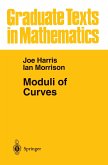Incorporated in this volume are the first two books in Mukai's series on moduli theory. The notion of a moduli space is central to geometry. However, its influence is not confined there; for example the theory of moduli spaces is a crucial ingredient in the proof of Fermat's last theorem. Researchers and graduate students working in areas ranging from Donaldson or Seiberg-Witten invariants to more concrete problems such as vector bundles on curves will find this to be a valuable resource. Amongst other things this volume includes an improved presentation of the classical foundations of invarant theory that, in addition to geometers, would be useful to those studying representation theory. This translation gives an accurate account of Mukai's influential Japanese texts.
Table of contents:
1. Invariants and moduli; 2. Rings and polynomials; 3. Algebraic varieties; 4. Algebraic groups and rings of invariants; 5. Construction of quotient spaces; 6. Global construction of quotient varieties; 7. Grassmannians and vector bundles; 8. Curves and their Jacobians; 9. Stable vector bundles on curves; 10. Moduli functors; 11. Intersection numbers and the Verlinde formula; 12. The numerical criterion and its applications.
This volume consists of the first two volumes of Mukai's series on moduli theory. The work contained here is central to geometry but has also found applications in a wide range of other areas. This book will be a valuable resource for graduate students and researchers alike.
This volume consists of the first two volumes of Mukai's series on moduli theory.
Hinweis: Dieser Artikel kann nur an eine deutsche Lieferadresse ausgeliefert werden.
Table of contents:
1. Invariants and moduli; 2. Rings and polynomials; 3. Algebraic varieties; 4. Algebraic groups and rings of invariants; 5. Construction of quotient spaces; 6. Global construction of quotient varieties; 7. Grassmannians and vector bundles; 8. Curves and their Jacobians; 9. Stable vector bundles on curves; 10. Moduli functors; 11. Intersection numbers and the Verlinde formula; 12. The numerical criterion and its applications.
This volume consists of the first two volumes of Mukai's series on moduli theory. The work contained here is central to geometry but has also found applications in a wide range of other areas. This book will be a valuable resource for graduate students and researchers alike.
This volume consists of the first two volumes of Mukai's series on moduli theory.
Hinweis: Dieser Artikel kann nur an eine deutsche Lieferadresse ausgeliefert werden.








